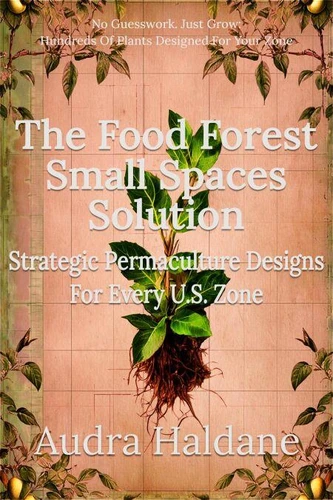- Accueil /
- Honey Shack Media
Honey Shack Media

Dernière sortie
The Food Forest Small Spaces Solution: Strategic Permaculture Designs for Every US Zone
Think you need acres of land to grow a food forest? Think again. Here's the reality:· Fresh food shouldn't cost a fortune-or require a farm. But when you're stuck with a cramped patio or a postage-stamp yard, it feels impossible to grow more than a few herbs.· Small spaces get chaotic fast. Which dwarf trees actually fruit in pots? How do you layer plants vertically without it looking like a jungle?· Most guides ignore you.
They assume you have room to sprawl. You don't. The Food Forest Small Spaces Solution: Strategic Permaculture Designs for Every US Zone is different. Here's how it works:1. Pick your USDA Zone (1-13). Flip to your section.2. Choose from small-space designs: Balcony-friendly fruit trees, patio shrubs, vertical vines, and even mushrooms that thrive in containers.3. Plant with confidence. Every layer is pre-planned for tight spaces.2 canopy layer plants, 2 understory plants, 2 shrub plants, 2 groundcover plants, 2 herbaceous layer plants, 2 root layer plants, 2 vertical layer plants, and 2 fungi plants! Mix, match, or follow them verbatim.
Why this solves your problem:· No yard? No problem. These designs can work for limited space.· No more wasted money. Every plant is tested for small-space survival (goodbye, dead dwarf citrus trees).· No guesswork. Layers are mapped for so your tiny Eden stays tidy and productive. This isn't a compromise. It's a revolution. Imagine plucking peaches from a patio tree, harvesting blueberries from a railing planter, or snipping tomatoes from a vertical garden-all while knowing your food is safe, fresh, and yours.
Small space. Big harvest.
They assume you have room to sprawl. You don't. The Food Forest Small Spaces Solution: Strategic Permaculture Designs for Every US Zone is different. Here's how it works:1. Pick your USDA Zone (1-13). Flip to your section.2. Choose from small-space designs: Balcony-friendly fruit trees, patio shrubs, vertical vines, and even mushrooms that thrive in containers.3. Plant with confidence. Every layer is pre-planned for tight spaces.2 canopy layer plants, 2 understory plants, 2 shrub plants, 2 groundcover plants, 2 herbaceous layer plants, 2 root layer plants, 2 vertical layer plants, and 2 fungi plants! Mix, match, or follow them verbatim.
Why this solves your problem:· No yard? No problem. These designs can work for limited space.· No more wasted money. Every plant is tested for small-space survival (goodbye, dead dwarf citrus trees).· No guesswork. Layers are mapped for so your tiny Eden stays tidy and productive. This isn't a compromise. It's a revolution. Imagine plucking peaches from a patio tree, harvesting blueberries from a railing planter, or snipping tomatoes from a vertical garden-all while knowing your food is safe, fresh, and yours.
Small space. Big harvest.
Think you need acres of land to grow a food forest? Think again. Here's the reality:· Fresh food shouldn't cost a fortune-or require a farm. But when you're stuck with a cramped patio or a postage-stamp yard, it feels impossible to grow more than a few herbs.· Small spaces get chaotic fast. Which dwarf trees actually fruit in pots? How do you layer plants vertically without it looking like a jungle?· Most guides ignore you.
They assume you have room to sprawl. You don't. The Food Forest Small Spaces Solution: Strategic Permaculture Designs for Every US Zone is different. Here's how it works:1. Pick your USDA Zone (1-13). Flip to your section.2. Choose from small-space designs: Balcony-friendly fruit trees, patio shrubs, vertical vines, and even mushrooms that thrive in containers.3. Plant with confidence. Every layer is pre-planned for tight spaces.2 canopy layer plants, 2 understory plants, 2 shrub plants, 2 groundcover plants, 2 herbaceous layer plants, 2 root layer plants, 2 vertical layer plants, and 2 fungi plants! Mix, match, or follow them verbatim.
Why this solves your problem:· No yard? No problem. These designs can work for limited space.· No more wasted money. Every plant is tested for small-space survival (goodbye, dead dwarf citrus trees).· No guesswork. Layers are mapped for so your tiny Eden stays tidy and productive. This isn't a compromise. It's a revolution. Imagine plucking peaches from a patio tree, harvesting blueberries from a railing planter, or snipping tomatoes from a vertical garden-all while knowing your food is safe, fresh, and yours.
Small space. Big harvest.
They assume you have room to sprawl. You don't. The Food Forest Small Spaces Solution: Strategic Permaculture Designs for Every US Zone is different. Here's how it works:1. Pick your USDA Zone (1-13). Flip to your section.2. Choose from small-space designs: Balcony-friendly fruit trees, patio shrubs, vertical vines, and even mushrooms that thrive in containers.3. Plant with confidence. Every layer is pre-planned for tight spaces.2 canopy layer plants, 2 understory plants, 2 shrub plants, 2 groundcover plants, 2 herbaceous layer plants, 2 root layer plants, 2 vertical layer plants, and 2 fungi plants! Mix, match, or follow them verbatim.
Why this solves your problem:· No yard? No problem. These designs can work for limited space.· No more wasted money. Every plant is tested for small-space survival (goodbye, dead dwarf citrus trees).· No guesswork. Layers are mapped for so your tiny Eden stays tidy and productive. This isn't a compromise. It's a revolution. Imagine plucking peaches from a patio tree, harvesting blueberries from a railing planter, or snipping tomatoes from a vertical garden-all while knowing your food is safe, fresh, and yours.
Small space. Big harvest.
Les livres de Honey Shack Media

The Food Forest Solution: Strategic Permaculture Designs For Every US Zone. The Food Forest Solution, #1
Honey Shack Media, Audra Haldane
E-book
9,49 €

The Food Forest Solution: Strategic Permaculture Designs For Every US Zone. The Food Forest Solution, #2
Honey Shack Media, Audra Haldane
E-book
9,49 €
